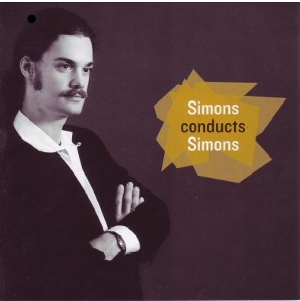 |
 |
|


alternatively
CD: MDT
AmazonUK
AmazonUS
Sound
Samples & Downloads |
Marijn SIMONS (b. 1982)
The Legend of Kwahkaazuh, Op.58a (2009) [25:58]
Five, Op.48a (2008-9) [18:24]
Bas Continues, Op.40b (2007-9) [5:20]
 Simon Ensemble (Philipp Stümke (clarinet); Ron Colbers (vibraphone,
vocal); Karina Sabac (piano); Felix Giglberger (violin, viola);
Sandra Borchers (contrabass))/Marijn Simons
Simon Ensemble (Philipp Stümke (clarinet); Ron Colbers (vibraphone,
vocal); Karina Sabac (piano); Felix Giglberger (violin, viola);
Sandra Borchers (contrabass))/Marijn Simons
rec. Theater aan het Vrijthof, Maastricht, 13 March 2010
 QUINTONE Q10004 [49:42]
QUINTONE Q10004 [49:42]
|
|
|
This CD begins as an interesting concatenation between classical
music and jazz, but soon turns into something rather different.
All the pieces here were originally written for solo instruments
and are here given in arrangements by the composer for a “kind
of jazz combo” played by musicians with impeccably classical
credentials. The Legend of Kwahkaazuh brings a whole
sheaf of classical quotations - Bach, Debussy and Prokofiev
among others more or less recognisable - and a number of hints
of fugal development. Simons has studied composition with James
MacMillan, and his music has the same kind of easy approachability.
There is nothing here to shock the horses. As the work proceeds
the jazz overtones become less and less apparent, and the track
Hopelessly perfect with its high violin writing and delicate
accompaniment brings an initial feeling of Arvo Pärt. It
is apparently a backwards version of the composer’s earlier
composition Perfectly hopeless which can be heard on
the composer’s own website.
Five is an arrangement for the same ensemble of an electronic
score written for the Gotra Ballet. It is purely classical in
tone with even a hint of Puccini’s Turandot in
the clarinet passage at 1:28 in the first movement. This is
less readily approachable than The Legend of Kwahkaazuh,
but has a delicate stillness that is most enticing. Bas continues
is a homage to classical bass continuo, and is charming if slight.
Simons is an interesting and still relatively young composer,
and one looks forward to his future development with interest.
He already has an impressive sheaf of commissions and performances.
We are told in the booklet that “Simons’s principle
is that concerts of contemporary music should be performed with
understanding, passion and conviction for them to be equally
successful in standard repertory concerts.” His performances
here certainly fulfil that ambition and the playing of the various
instruments - one might single out the energetic Felix Giglberger
on violin - is superlatively responsive. One’s main criticism
of this CD must be the rather meagre playing time, but that
presumably arises from the fact that the recordings were made
during the dress rehearsal and première concert by this
ensemble. There is no hint of any audience noise, or indeed
any applause at the end of numbers.
Paul Corfield Godfrey
|
|

